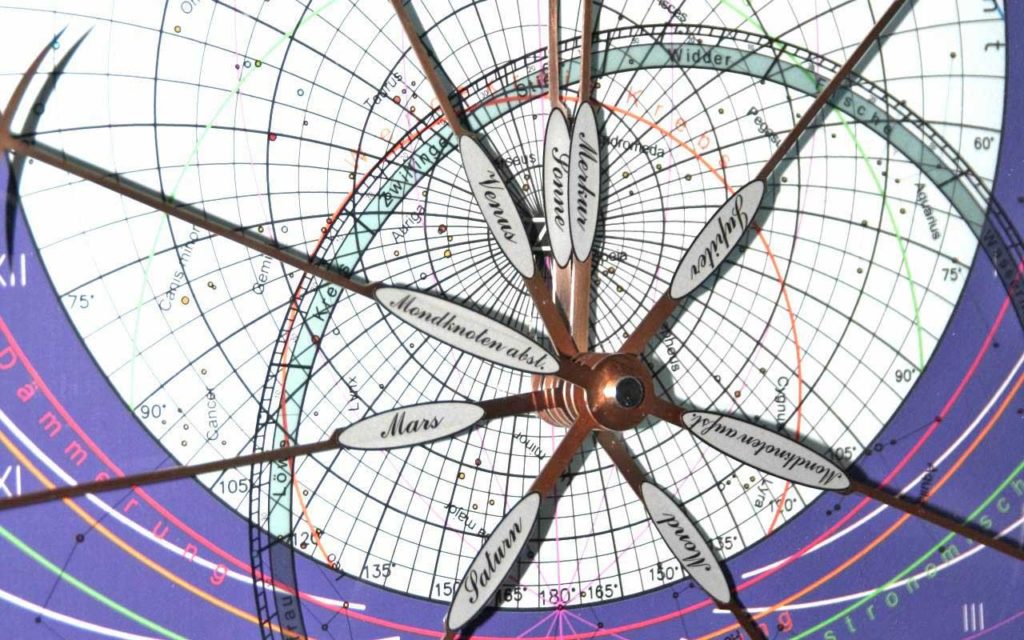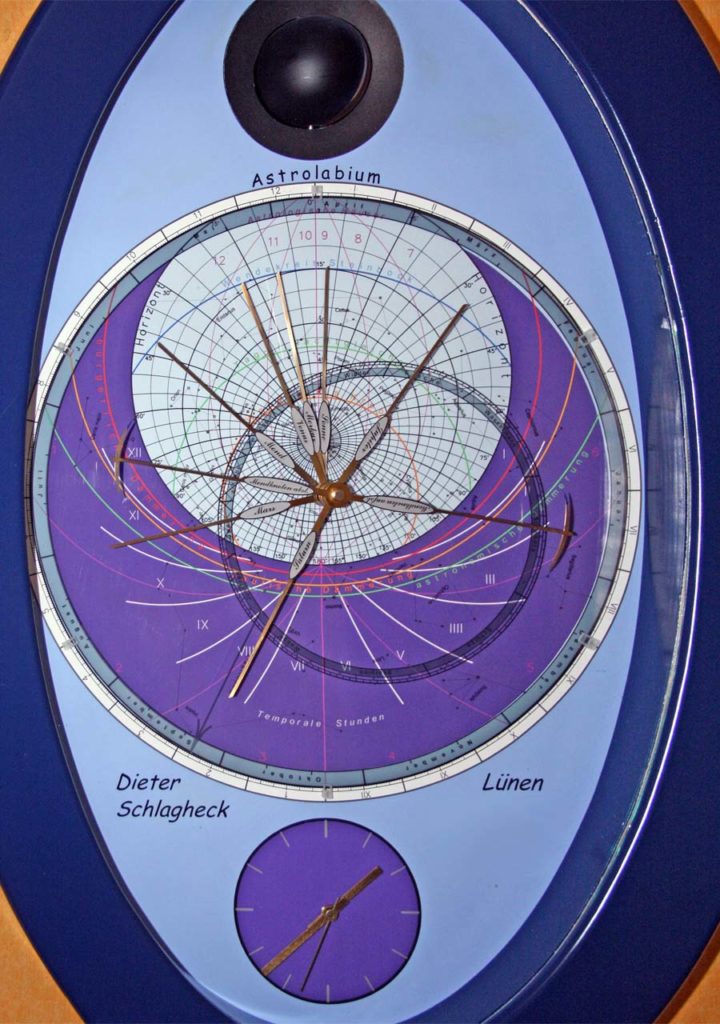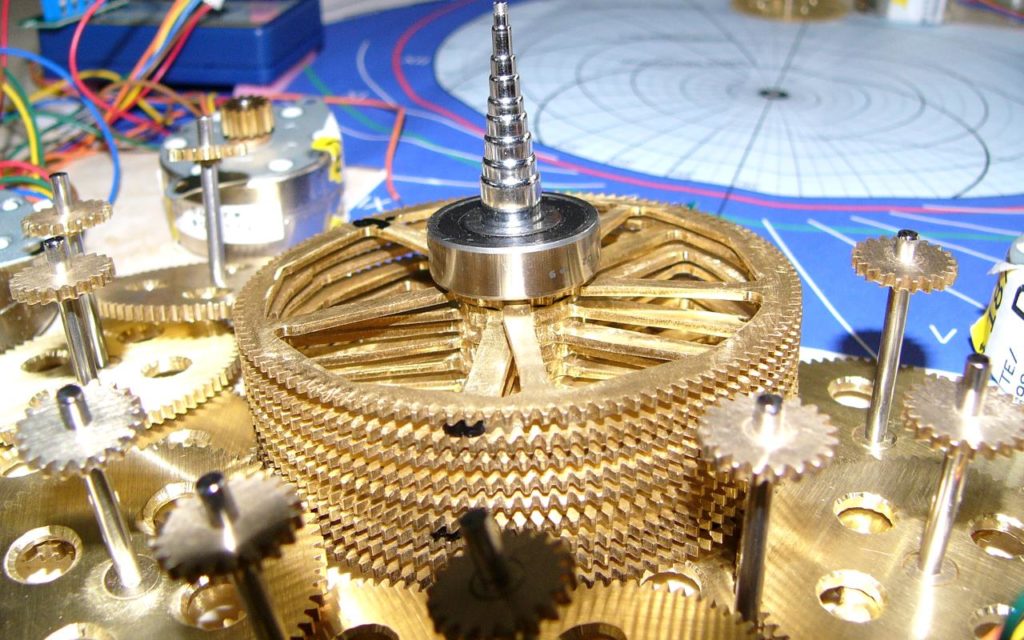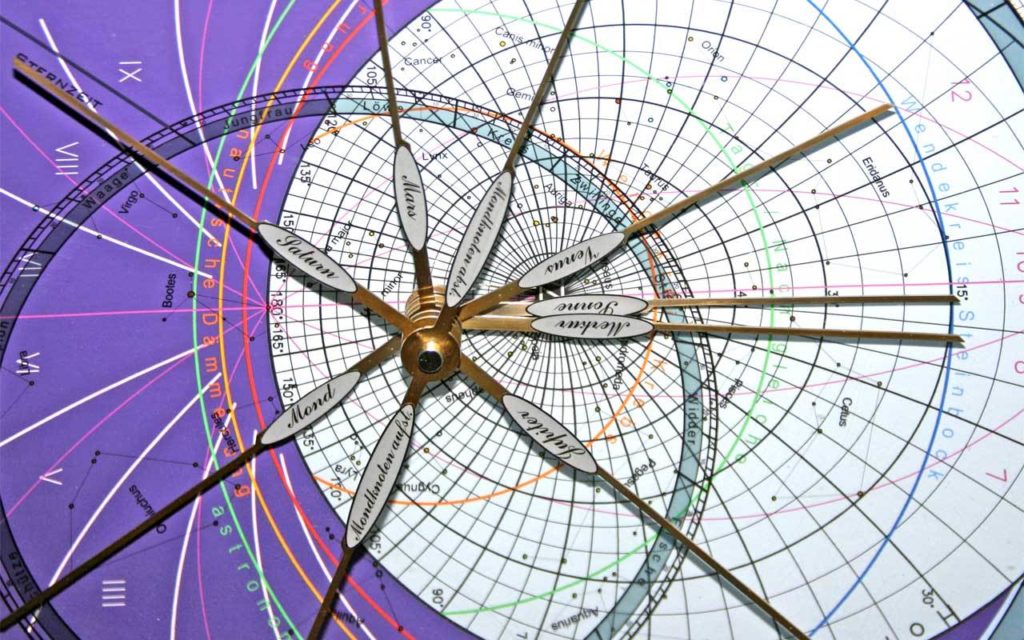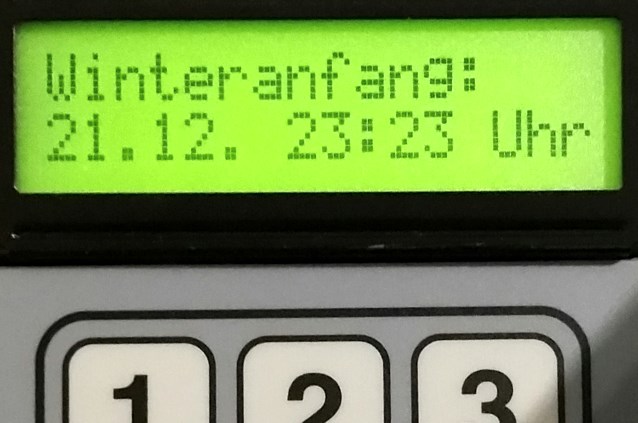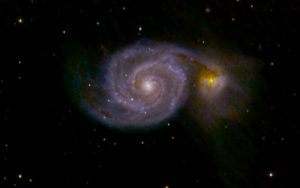Astrolabe by Dieter Schlagheck
An astrolabe determines positions of stars for a given time and geographic latitude. If the celestial sphere is plotted on a plate due to an angle-preserving stereographic projection of the celestial circles, than we can find on the edge the hour circle = limbus, inside rotates the replaceable horizon disk = tabula and hereon the paths of some stars and the ecliptic or annual path of the sun = rete. In the maritime shipping the geographic latitude was determined with an astrolabe. The whole astrolabe (full circle) became a half astrolabe (half circle), a quadrant (fourth part of a circle), a sextant (sixth part of a circle) and a octant (eighth part of a circle).
The northern polar star is the center and pivot point for a astrolabe of the northern celestial hemisphere. The positions of the stars can be read with a given date and time und vice versa, the time or the cardinal points can be read with a given date and star position or sun position. That way the astrolabe was used as chronometer and for the determination of the calendar dates. With an additional clockwork it reproduces the paths of the sun and usually also of the moon. Rarely someone tried to display on an astrolabe the complex orbits of the planets.
My colleague Dieter Schlagheck from Lünen in Germany finished 2006 his astrolabe, with planetary configurations, sunrise and sunset and phases of the moon. Servomotors are moving nine clock hands, for the actual position of the visible five of the eight planets, of the sun, of the moon and of the lunar node (for the display of solar eclipses and lunar eclipses), the star disk and the moon sphere (for the display of the phase of the moon). Likewise the date with the corresponding time from the year 1 up to the year 2499 can be typed in on a keypad and the therfore gained information will be shown on a display.
Dieter Schlagheck designed the device, calculated the planetary orbits and made the programming. He made gear wheels, build in the motors and laser barriers. Thus he created a worldwide unique highly complex device which he introduces in presentations to an interested professional audience.
The astrolabe of the physicist Dieter Schlagheck shows us e.g. where tonight are located the signs of the zodiac and when we best can admire Saturn, Venus or Mars at the evening sky. As well we can explore when will be Easter and that at the 14th of April 1912, when the Titanic sank, the moon wasn’t shining and it was completely dark.
Usage
Case
Dimensions
Displays
for a specific geographic position
elliptic
80 x 50 x 10 cm
At the top is located a rotating sphere for the visualization of the actual phase of the moon. In the middle is an astrolabe, that means there are displayed the positions of the sun, of the moon, of the visible planets (Mercury, Venus, Mars, Jupiter, Saturn) and the location of the lunar node. Furthermore there is a transparent disk, which contains the sidereal time, the brightest 240 stars and the associated signs of the zodiac as well as the ecliptic. The intersection point of the hand for the sun, the moon and the planets with the ecliptic results in the actual position at the sky. With the aid of the lunar node hand the sun eclipses and moon eclipses maybe determined too. At the bottom is implemented a conventional radio-controlled clock.
LCD-display and keypad
On the top left side of the frame can be pulled out a LCD-display with a keypad with variety of additional information such as:
– times of the sunrise and moonrise and the sunset and moonset,
– beginning of the seasons, exact to the minute,
– the actual sidereal time and the phase of the moon.
With the keypad can be typed in also any date between the year 1 and 2499 with a corresponding time. The astronomic information will be displayed for this data too with a high accuracy.
Construction
The hands, the sphere, the star disk and the moon sphere are moved by 10 step motors. Any tracing is translated by a total of 40 gear wheels with a resolution of 1440 steps per rotation (240 steps there are for the phase of the moon).
The step motors are controlled by an integrated microcomputer with a therefore developed electronics. The microcomputer contains the complete program to receive the time and date and for the control of the step motors. After a power blackout the accurate position of the hands will be adjusted by a special program.
The clock face of the astrolabe contains the degrees of longitude and latitude in steps of 5°. Furthermore there are plotted the proportional hours, the astrological houses and the lines for the civil, the nautical and the astronomical twilight. This design corresponds to a large extend that of the astronomical clock faces of the Middle age.
The hands of the astrolabe were designed with a CAD program and made with the laser cutting technique. After a several times applied electrolytic coating they finally were gold plated. In the outer frame is inserted a super anti glare safety glass.
The first time the astrolabe was put into operation was in the year of 2006 and since then it works faultless.
All our videos you will find at our channel following: https://www.youtube.com/channel/UCUtV5VmLRWGHHN17yG_S_pQ

